Difference between revisions of "Metaforsa 3/3.plus/grc"
(Created page with "{| class="wikitable" style="width:800px"; |- |colspan="2" style="background-color:#dededf" |'''Προσοχή: Πριν από την παροχή ρεύματος στη βα...") Tags: Mobile web edit Mobile edit |
(Created page with "====Σύνδεση μονοπολικού ενεργοποιητή πύλης====") Tags: Mobile web edit Mobile edit |
||
| Line 358: | Line 358: | ||
| − | ==== | + | ====Σύνδεση μονοπολικού ενεργοποιητή πύλης==== |
{{ConExC | {{ConExC | ||
Revision as of 14:39, 8 April 2024
| MF3/MF3.plus | |||||||||||||
|---|---|---|---|---|---|---|---|---|---|---|---|---|---|
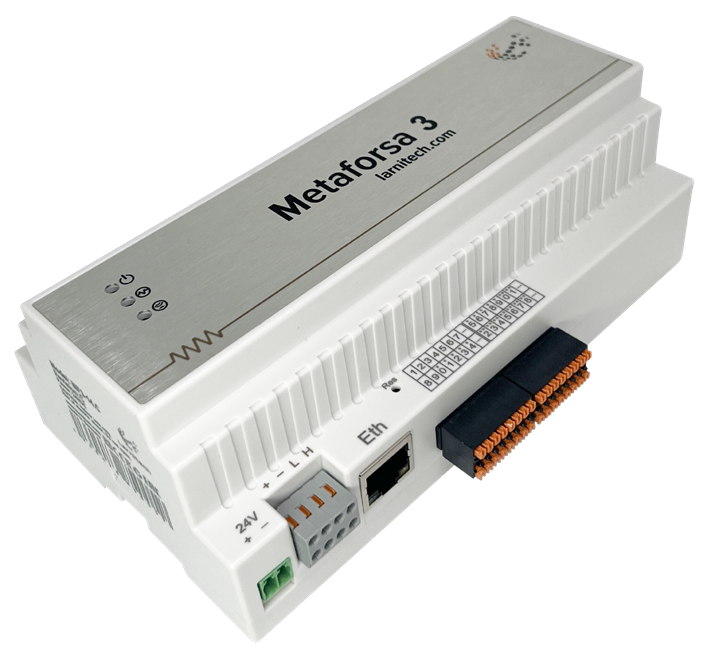 | |||||||||||||
| |||||||||||||
| |||||||||||||
| |||||||||||||
| |||||||||||||
Εισαγωγή
Το εγχειρίδιο εγκατάστασης METAFORSA SMART HOUSE περιγράφει τη διαδικασία εγκατάστασης, συναρμολόγησης, λειτουργίας και ρύθμισής του. Κατά την εργασία με το σύστημα, πρέπει να συμμορφώνεστε αυστηρά με όλες τις απαιτήσεις που ορίζονται σε αυτό το εγχειρίδιο. Η μη συμμόρφωση μπορεί να οδηγήσει σε ζημιά στη συσκευή, αστοχία της, ηλεκτροπληξία, πυρκαγιά και άλλες επιπτώσεις. Ο κατασκευαστής διατηρεί το δικαίωμα να κάνει αλλαγές σε αυτό το εγχειρίδιο χωρίς προηγούμενη ειδοποίηση. Αυτό το εγχειρίδιο αποτελεί αναπόσπαστο μέρος του συστήματος και θα παραμείνει στον πελάτη τελικής χρήσης.
Χαρακτηριστικά
- Υποστήριξη 10 καθολικών εξόδων:
- Φώτα
- Βαλβίδες θέρμανσης NC/NO
- Περσίδες
- Πύλες 1 ή 2 πόλων
- 1 ή 2πολικές βαλβίδες
- Κλειδαριές NC/NO
- Μονάδες fan coil
- 4 εξόδους μείωσης της φωτεινότητας
- 28 είσοδοι που υποστηρίζουν:
- Κουμπιά
- Κουμπιά LED
- Διακόπτες
- Διακόπτες καλαμιών
- Αισθητήρες διαρροής
- Ανιχνευτές κίνησης
- Αισθητήρες θερμοκρασίας
- Λωρίδες LED
- Λωρίδες RGB 3-4-5 καναλιών
- Λωρίδες WS2812B
- Συσκευές RS485 (μόνο για Metaforsa 3.plus)
- Θύρα επέκτασης
- Ρελέ με επαφές AgSnO2 με ονομαστική τιμή ρεύματος εισόδου 80A 20ms
- Σύνδεση cloud και έλεγχος όλων των συστημάτων του σπιτιού
- Φωνητικός έλεγχος (Siri, Alexa, Google Home)
Απαιτήσεις ασφαλείας
Για να αποφευχθεί ο κίνδυνος πυρκαγιάς, ηλεκτροπληξίας, ζημιάς στο σύστημα ή/και τραυματισμού, η εγκατάσταση και η συναρμολόγηση του συστήματος πρέπει να εκτελούνται σύμφωνα με τις οδηγίες που αναφέρονται παρακάτω:
- Όλες οι εργασίες σύνδεσης πρέπει να εκτελούνται χωρίς ρεύμα.
- χρησιμοποιήστε κατάλληλα εργαλεία και προσωπική προστασία από ηλεκτροπληξία.
- μην χρησιμοποιείτε κατεστραμμένα καλώδια, καλώδια και συνδέσμους.
- αποφύγετε την αναδίπλωση των καλωδίων και των καλωδίων.
- μην τσιμπήσετε ή τσακίσετε τα καλώδια και τα καλώδια ασκώντας υπερβολική δύναμη. Διαφορετικά, οι εσωτερικοί αγωγοί του καλωδίου και των καλωδίων μπορεί να απογυμνωθούν ή να σπάσουν.
- Μην χρησιμοποιείτε την πρίζα με κακές επαφές για σύνδεση.
- μην υπερβαίνετε το όριο των παραμέτρων φορτίου που καθορίζεται σε αυτό το εγχειρίδιο.
- το τμήμα σύρματος των αγωγών τροφοδοσίας υπόκειται στις προδιαγραφές για όριο πυκνότητας ρεύματος, τύπο μόνωσης και υλικό σύρματος. Το ελαφρύ τμήμα μπορεί να προκαλέσει υπερθέρμανση του καλωδίου και πυρκαγιά.
Όταν εργάζεστε με το σύστημα μετά την παροχή τάσης ΠΟΤΕ:
- πραγματοποιήστε σύνδεση/αποσύνδεση των βυσμάτων.
- ανοιχτές μονάδες και αισθητήρες.
Διαμόρφωση συστήματος και σκοπός
Σκοπός του συστήματος
Το METAFORSA SMART HOUSE είναι μια έτοιμη λύση για την αυτοματοποίηση οικιστικών και επαγγελματικών χώρων, ξενοδοχειακών συγκροτημάτων που περιλαμβάνει τα πιο επιθυμητά χαρακτηριστικά του Smart House.
Η συσκευή διαθέτει 10 κανάλια ελέγχου, 4 κανάλια dimming και 28 κανάλια εισόδου ποσ.
| Οι καθολικές έξοδοι μπορούν να χρησιμοποιηθούν για τον έλεγχο: | Οι καθολικές είσοδοι σάς επιτρέπουν να συνδέσετε: |
|---|---|
| Φωτισμός | Κουμπιά/κουμπιά LED/μονάδες μεταγωγής |
| Υποδοχές | Διακόπτες μαγνητικού καλαμιού |
| Ενδοδαπέδια θέρμανση | Αισθητήρες διαρροής |
| Κουρτίνα | Ανιχνευτές κίνησης |
| Ενεργοποιητές πύλης | Αισθητήρες θερμοκρασίας |
| Ύδρευση | Λωρίδες LED/λωρίδες RGB 3-4-5 καναλιών/Λωρίδες WS2812B |
| Βαλβίδες θέρμανσης | Συσκευές RS485* |
* – Μόνο για το Metaforsa 3.plus
'Θύρα επέκτασης
Η θύρα επέκτασης σάς επιτρέπει να αναβαθμίσετε το σύστημα συνδέοντας βοηθητικό εξοπλισμό, όπως η ηλεκτρονική μονάδα ελέγχου για φωτισμό LED, ρύθμιση φωτεινότητας, συσκευές μέτρησης και άλλα στοιχεία.
Το πακέτο, το οποίο είναι πλήρως έτοιμο για εγκατάσταση, περιλαμβάνει το βασικό υλικό και λογισμικό.
Περιεχόμενα πακέτου
Το πακέτο συνοδεύεται στάνταρ με:
| Mainframe METAFORSA 3/3.plus | 1 τεμ |
| Τροφοδοτικό MEANWELL DR-15-12 | 1 τεμ |
| Αισθητήρας κίνησης CW-MSD | 3 τεμ |
| Αισθητήρας διαρροής FW-WL.B | 2 τεμ |
| Στοιχείο ευαίσθητο στη θερμοκρασία FW-TS | 4 τεμ |
| Μαγνητικός διακόπτης καλαμιού (αισθητήρας θέσης παραθύρου/πόρτας) | 4 τεμ |
| Φίλτρο θορύβου καλωδίου Ethernet | 1 τεμ |
| Καλώδιο τροφοδοσίας | 1 τεμ |
Βασικές τεχνικές προδιαγραφές του Συστήματος
Οι βασικές προδιαγραφές και τα χαρακτηριστικά της ενότητας METAFORSA 3/3.plus φαίνονται στον πίνακα 1
| Προδιαγραφές | Εννοια |
|---|---|
| 'Θύρες εξόδου | |
| Αριθμός εναλλασσόμενων καναλιών | 10 |
| Αριθμός αλλαγμένων ομάδων | 10 |
| Αριθμός καναλιών μείωσης φωτεινότητας | 4 |
| Τάση μεταγωγής | 0-250 V AC/DC |
| Φορτίο αιχμής (ένα κανάλι) | 16Α |
| Φορτίο αιχμής (συσκευή) | 160Α |
| Μέγιστο φορτίο ανά κανάλι μείωσης φωτεινότητας | 0,5A (110W στα 220V) |
| Τύπος ροοστάτη | MOSFET |
| Τύπος φορτίου Dimmer | R,C |
| Τύπος φωτισμού | χείλος εκφυγής |
| Τύπος σύνδεσης καλωδίου τροφοδοσίας | σύνδεσμος |
| Επιτρεπόμενο τμήμα του καλωδίου τροφοδοσίας για σύνδεση στην πρίζα: καλώδιο ενός αγωγού καλώδιο πολλαπλών αγωγών καλώδιο πολλαπλών αγωγών με μύτη |
0,5 … 4mm2 0,5 … 4mm2 0,5 … 2,5 mm2 |
| Θύρες εισόδου | |
| Αριθμός διακριτών εισόδων | 28 |
| Μέγιστη ονομαστική τιμή ρεύματος στους συνδετήρες τάσης συνεχούς ρεύματος | 5 mA* |
| Άλλα' | |
| Θερμοκρασία περιβάλλοντος λειτουργίας | 0 … +45°С |
| Θερμοκρασία αποθήκευσης/μεταφοράς | -10 … +50°С |
| Επιτρεπτή υγρασία | 0 … 95% (χωρίς συμπύκνωση) |
| Τροφοδοσία | 11,5 … 27,5 V DC 24V, 0,75A Συνιστάται |
| Μέγιστη ζήτηση | 0,5Α |
| Διαθέσιμες διεπαφές | Ethernet, CAN |
| Τύπος λεωφορείου | CAN (4-σύρματα) |
| CAN (4-wire) | 800 m** (συνεστραμμένο ζεύγος CAT5e) |
| Τύπος σύρματος CAN | FTP Cat 5E |
| Τύπος σύνδεσης CAN | Συνδετήρας |
| Μέγιστο μήκος ψηφιακής γραμμής | 30 μ |
| Τύπος καλωδίου ψηφιακής γραμμής | UTP/FTP Cat 5E |
| Μέγιστο μήκος LAN | 100 μ |
| Τύπος καλωδίου LAN | UTP/FTP Cat 5E |
| Τύπος σύνδεσης LAN | Σύνδεσμος RJ-45 |
| Ποσότητα θυρών RS485 | 1*** |
| Ταχύτητα μεταφοράς δεδομένων | 1200-115200 b/s*** |
| Προδιαγραφές διαστάσεων | 9U, 156x90x58 mm |
| Υλικό κελύφους | ABS |
| Κάσα | IP40 |
| Τύπος εγκατάστασης εξοπλισμού | DIN-rail (EN 60715) |
| Βάρος | 400 γρ |
* – Τα κανάλια εξόδου πρέπει να συνδέονται μόνο με χρήση ενισχυτή που χρησιμοποιεί σήμα 5V PWM από την έξοδο IO ως είσοδο
** – η εγκατάσταση πρόσθετων μονάδων τροφοδοσίας απαιτείται για μεγάλες γραμμές. το μέγιστο μήκος της γραμμής μπορεί να μειωθεί από διάφορους παράγοντες παρεμβολής
*** – Μόνο για το Metaforsa 3.plus
Γενική δομή του Συστήματος
Η γενική όψη της μονάδας εμφανίζεται στο 'εικ. 1
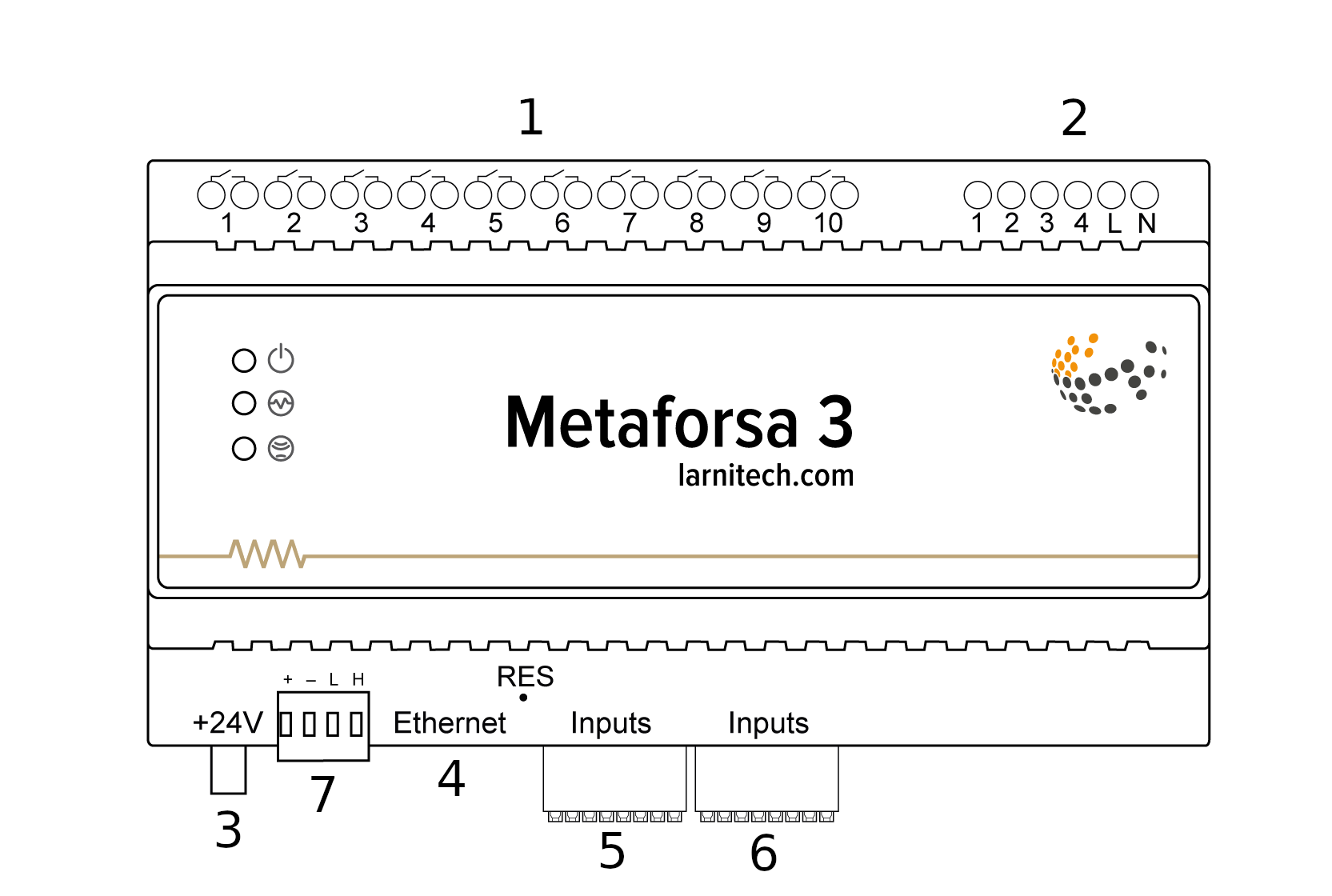
| 1 | — σύνδεσμος για εφαρμογή φορτίου |
| 2 | — σύνδεσμος για εφαρμογή λαμπτήρων φωτισμού |
| 3 | — βύσμα τροφοδοσίας |
| 4 | — Υποδοχή δικτύου Ethernet |
| 5-6 | — υποδοχές για γενικά κανάλια εισόδου/εξόδου |
| 7 | — σύνδεσμος για μονάδα επέκτασης. |
Επισκόπηση των εξωτερικών βυσμάτων της συσκευής METAFORSA:
Στο επάνω μέρος του περιβλήματος ('εικ. 1') υπάρχει:
- υποδοχή (1) — Σύνδεση συσκευών.
- Βύσμα (2) — Σύνδεση λαμπτήρων μείωσης της έντασης του φωτός.
Στο κάτω μέρος του περιβλήματος ('εικ. 1') υπάρχει:
- βύσμα (3) — σύνδεση τροφοδοτικού μονάδας.
- σύνδεση (4) — Σύνδεση δικτύου Ethernet.
- υποδοχές (5-6) — σύνδεση καναλιών γενικής εισόδου/εξόδου – κουμπιά, διακόπτες καλαμιού, κουμπιά LED, αισθητήρες διαρροής, αισθητήρες κίνησης, αισθητήρες θερμοκρασίας, λωρίδες LED, ταινίες RGB 3-4-5 καναλιών, ταινίες WS2812B, συσκευές RS485 ( Μόνο για το Metaforsa 3.plus);
- υποδοχή (7) — σύνδεση μονάδας επέκτασης.
Η φυσική διαμόρφωση και η αντιστοίχιση σημείων επαφής κάθε βύσματος φαίνονται στον πίνακας 2.
| Σύνδεσμος | Επικοινωνία | Ανάθεση |
|---|---|---|
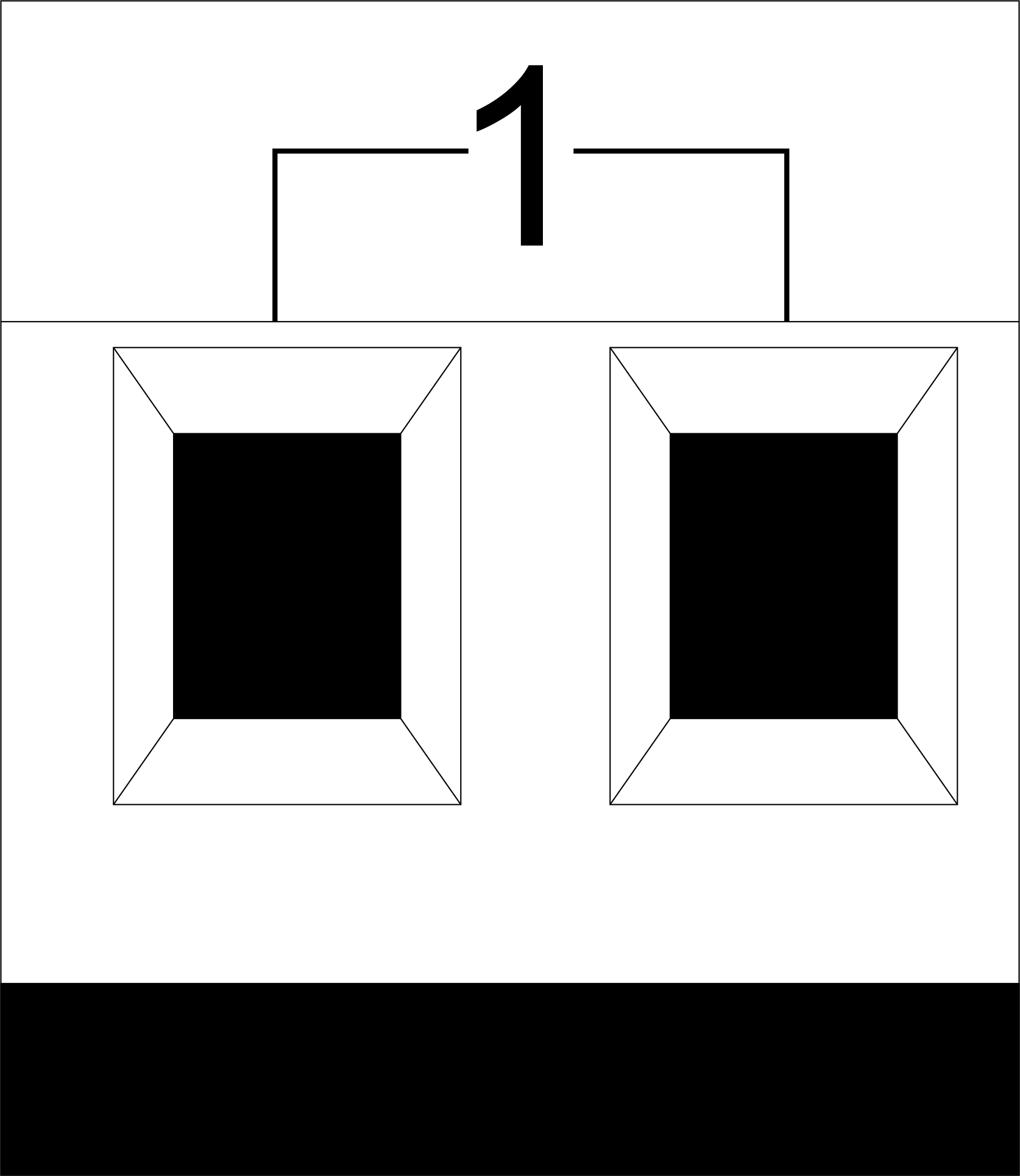 |
1-10 | Εφαρμογή φορτίου (λαμπτήρες φωτός, θερμικοί ενεργοποιητές κ.λπ.) |
| D1-4, L, N | Εφαρμογή φόρτωσης (λαμπτήρες φωτισμού) | |
| Ενδείξεις κατάστασης συσκευής | Οι δείκτες κατάστασης της μονάδας περιγράφονται στον πίνακα 3 | |
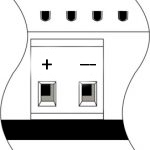 |
+24V GND |
+24V — τροφοδοσία μονάδας από εξωτερικό τροφοδοτικό 24 V GND — κοινό |
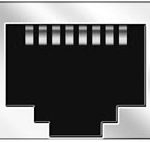 |
RJ45 | Υποδοχή για σύνδεση LAN |
| In1-14, In15-28 GND | Σύνδεση συσκευών ελέγχου (κουμπιά, κουμπιά LED, διακόπτες μαγνητικού καλαμιού, ανιχνευτές κίνησης, αισθητήρες διαρροής, αισθητήρες θερμοκρασίας κ.λπ.): In1 … In28 — λογικές είσοδοι GND — κοινές | |
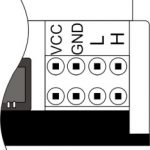 |
VCC GND L H |
Σύνδεση εξωτερικών μονάδων για CAN-bus VСС — Έξοδος 24V για εξωτερικές συσκευές τροφοδοτικό GND — συνηθισμένο L — Δίαυλος δεδομένων CAN-L H — Δίαυλος δεδομένων CAN-H |
| Indicator | Status | Description |
|---|---|---|
| Power | Power | |
| Power not available | ||
| Activity | Data communication | |
| Data communication not available | ||
| Error | No errors | |
| Communication error | ||
| Module overheat | ||
| Dimmer outputs module overload | ||
| Absence of power on dimmers, if in configuration |
Εγκατάσταση και συναρμολόγηση συστήματος
Πριν συνδέσετε το σύστημα, πρέπει:
- τοποθετήστε τον αισθητήρα και τους ενεργοποιητές (αν δεν είναι προεγκατεστημένοι), ρυθμίστε τους αισθητήρες και τους ενεργοποιητές.
- τοποθετήστε τη μονάδα και το τροφοδοτικό.
- το σήμα τον αισθητήρα και τους ενεργοποιητές (αν δεν είναι προεγκατεστημένοι), ρυθμίστε τους αισθητήρες και τους ενεργοποιητές.
- το αυτοκίνητο τη μονάδα και το τροφοδοτικό.
- Η ισχύς του συγκροτήματος διακόπτη κυκλώματος πρέπει να συμμορφώνεται με την ικανότητα φόρτωσης.
- Τίποτα άλλο εκτός από τους αγωγούς φάσης δεν μπορεί να συνδεθεί στη μονάδα, το ουδέτερο καλώδιο συνδέεται χωριστά.
Το τυπικό διάγραμμα της σύνδεσης μονάδας METAFORSA 3/3.plus φαίνεται στο εικ. 3.
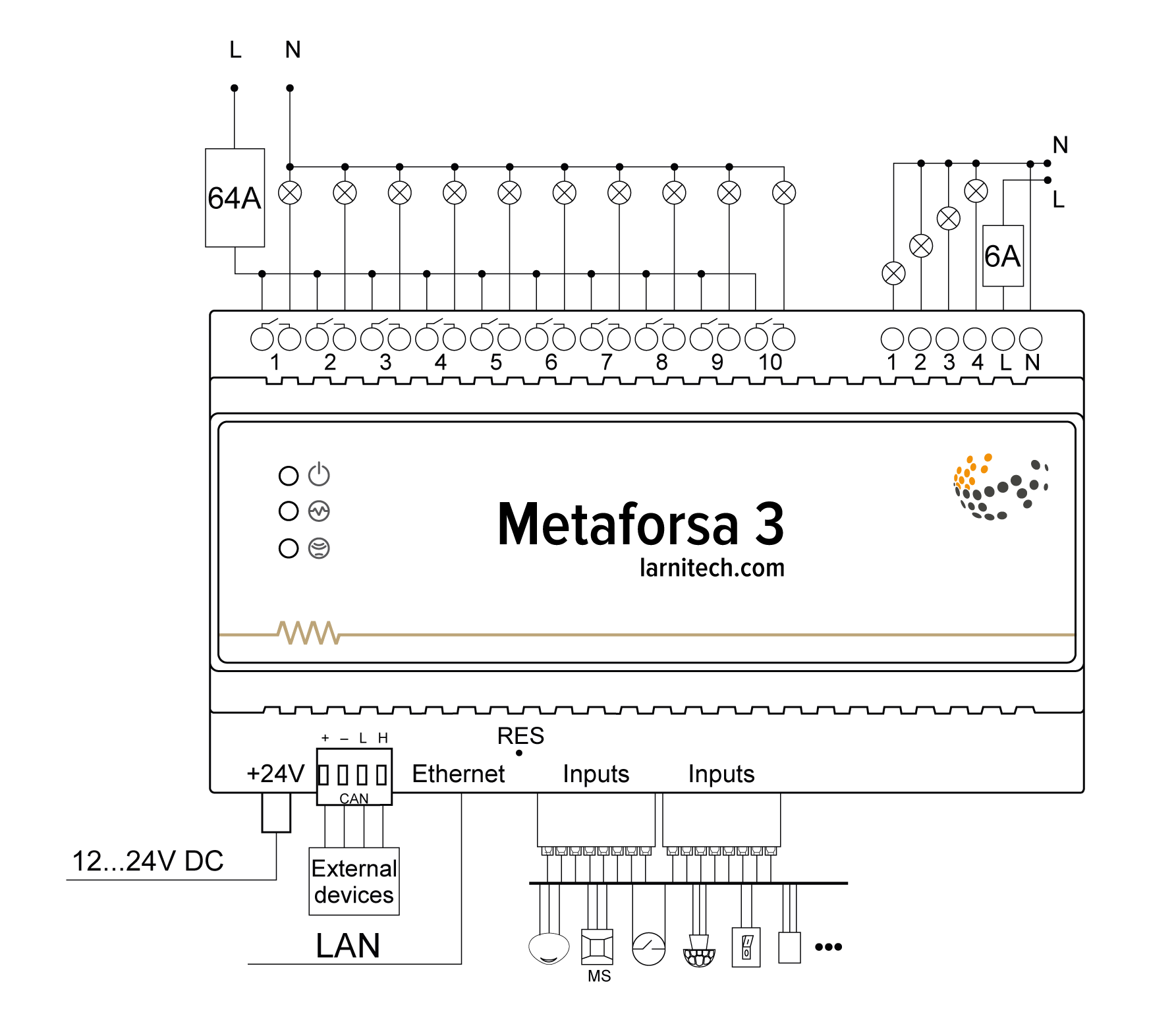
Σύνδεση των ενεργοποιητών
Σύνδεση των φώτων/ηλεκτρικού επαφέα/θερμικού ενεργοποιητή θέρμανσης
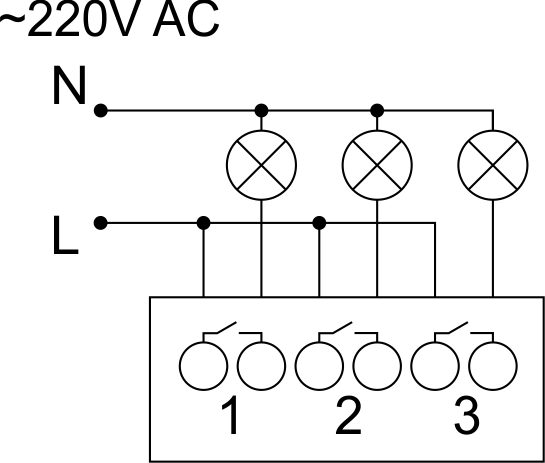 Εικ. 4 |
Τέτοιοι ενεργοποιητές όπως φως, ηλεκτρικός επαφέας, θερμικός ενεργοποιητής θέρμανσης θα πρέπει να ενεργοποιούνται σε οποιαδήποτε από τις εξόδους 1 – 10, το ουδέτερο καλώδιο και το καλώδιο γείωσης πρέπει να συνδέονται απευθείας στον πίνακα διανομής. Το παράδειγμα σύνδεσης φαίνεται στο Εικ.4. |
Σύνδεση συσκευής υψηλού φορτίου
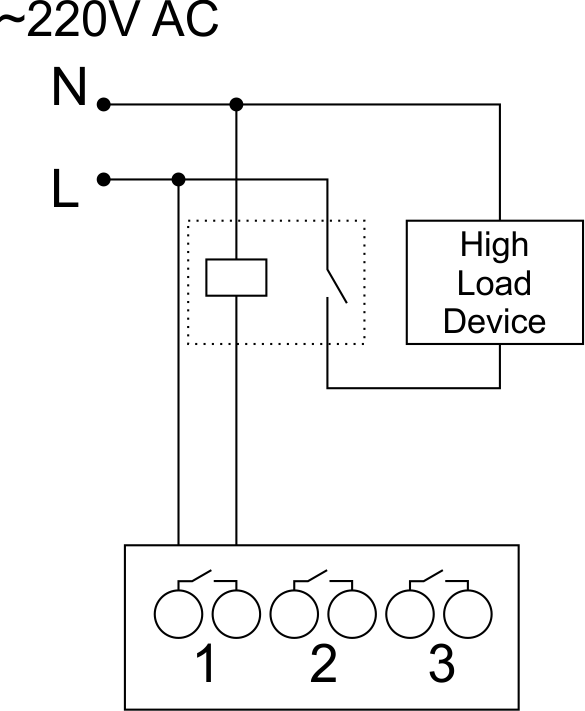 |
Προτεινόμενοι επαφές:
|
Σύνδεση μονοπολικής βαλβίδας παροχής νερού/αερίου
| Προσοχή: Πριν βάλετε ρεύμα στο φορτίο, βεβαιωθείτε ότι η διαμόρφωση εξόδου της μονάδας METAFORSA είναι σωστή. Η λανθασμένη διαμόρφωση ή η εσφαλμένη σύνδεση μπορεί να προκαλέσει την αστοχία της μονάδας ή/και την αστοχία του εξοπλισμού που είναι συνδεδεμένος σε αυτήν, ακόμη και πυρκαγιά. | |
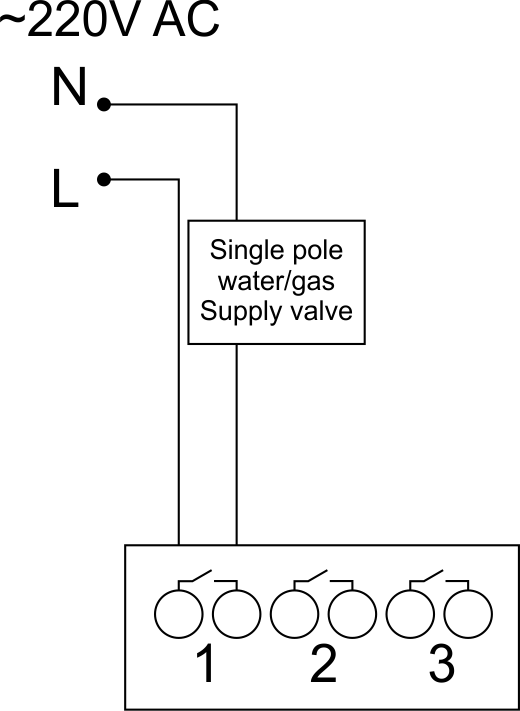 Εικ. 5 |
Η μονοπολική βαλβίδα παροχής νερού/αερίου συνδέεται σε οποιαδήποτε από τις εξόδους 1 – 10, το (το ουδέτερο καλώδιο και το καλώδιο γείωσης συνδέονται απευθείας στον πίνακα διανομής. Το παράδειγμα σύνδεσης φαίνεται στο 'Εικ.5 '. |
Σύνδεση διπολικής βαλβίδας παροχής νερού/αερίου
| Προσοχή: Πριν από την παροχή ρεύματος στη βαλβίδα, είναι απαραίτητο να βεβαιωθείτε ότι η διαμόρφωση εξόδου της μονάδας METAFORSA είναι σωστή. Η λανθασμένη διαμόρφωση μπορεί να προκαλέσει την εφαρμογή τάσης ταυτόχρονα και στα δύο κανάλια της βαλβίδας, η οποία μπορεί να οδηγήσει σε αστοχία της μονάδας ή/και αστοχία του εξοπλισμού που είναι συνδεδεμένος σε αυτήν, ακόμη και σε πυρκαγιά. | |
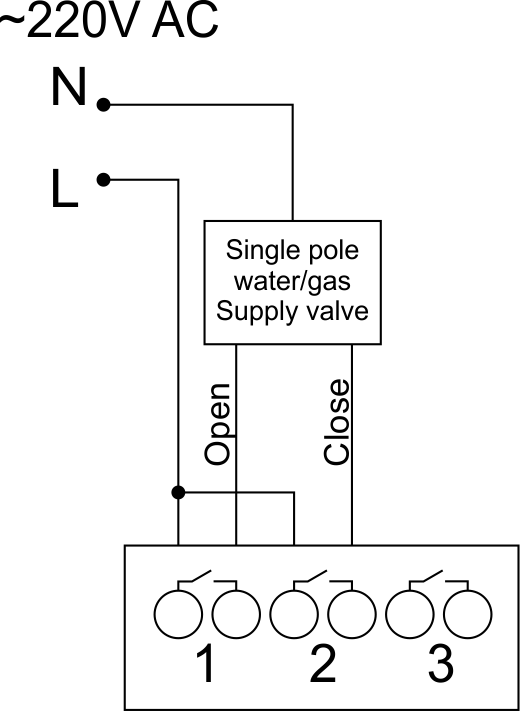 Εικ. 6 |
Δύο γειτονικά σημεία επαφής (για παράδειγμα, 3, 4) χρησιμοποιούνται για τη σύνδεση της διπολικής βαλβίδας παροχής νερού/αερίου. Σε αυτές τις συνθήκες το ουδέτερο καλώδιο και το καλώδιο γείωσης συνδέονται απευθείας στον πίνακα διανομής. Το παράδειγμα σύνδεσης φαίνεται στο Εικ.6. |
Σύνδεση μονοπολικού ενεργοποιητή πύλης
| Caution: Before applying power to the module, you should properly configure access to the application. The contacts incorrectly configured can result in the module failure and/or failure of the equipment connected to it, and even a fire.
| |
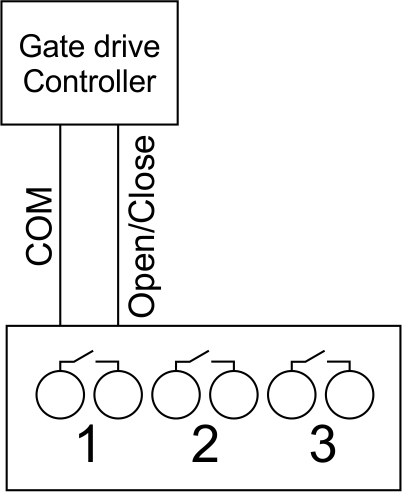 Fig. 7 |
Any contact point (for example, 3) is used to connect the single-pole gate drive controllers. The example of connection is shown in Fig.7. |
Connection of double-pole gate actuator
| Caution: Before applying power to the module, you must properly configure the outputs in the application. The contacts configured incorrectly can lead to simultaneous power supply to both channels, resulting in the module failure and/or failure of the equipment connected to it, and even a fire.
| |
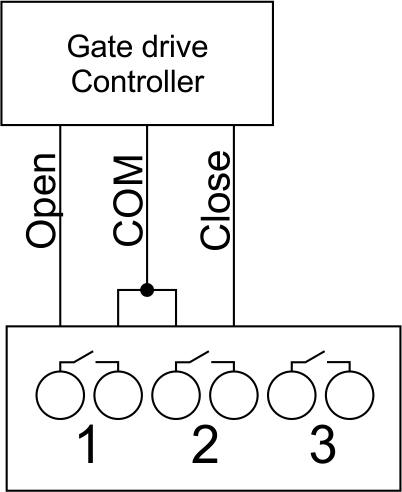 Fig. 8 |
Two adjacent contact points (for example, 3, 4) should be used to connect the double-pole gate drive controller. The example of connection is shown in Fig.8. |
Connection of curtain/jalousie/shutter actuator with 220V force control
| Caution: Before applying power to the module, you must properly configure the outputs in the application. The contacts configured incorrectly can lead to simultaneous power supply to both channels, resulting in the module failure and/or failure of the equipment connected to it, and even a fire.
| |
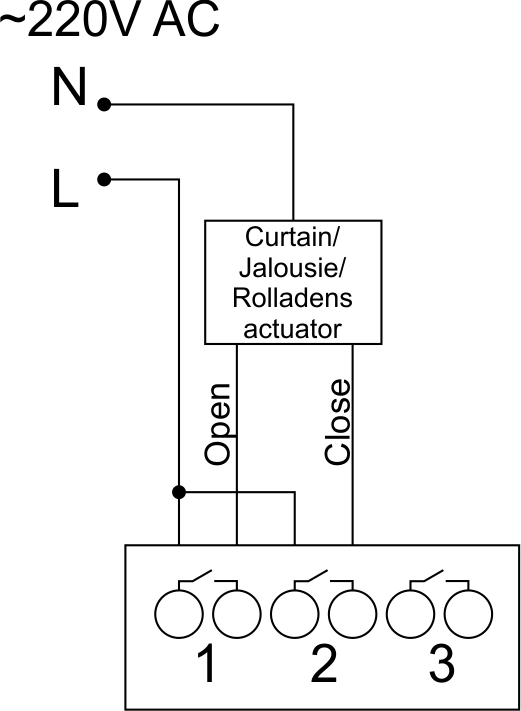 Fig. 9 |
Two adjacent contact points (for example, 3, 4) should be used to connect the curtain/jalousie/rolladens actuator, in these conditions the neutral wire and the ground wire are connected directly to the switchboard. The example of connection is shown in Fig.9. |
Connection of curtain/jalousie/shutter actuator with low-voltage control
| Caution: Before applying power to the module, you must properly configure the outputs in the application. The contacts configured incorrectly can lead to simultaneous power supply to both channels, resulting in the module failure and/or failure of the equipment connected to it, and even a fire.
| |
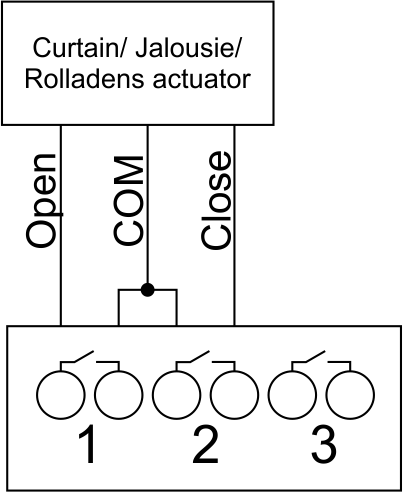 Fig. 10 |
Two adjacent contact points (for example, 3, 4) should be used to connect the curtain/jalousie/rolladens actuator with low-voltage control. The example of connection is shown in Fig.10. |
Connection of sensing elements/switches/buttons
Connection of motion sensors/leakage sensors
The motion sensors/leakage sensors should be connected to any free input in1-in28; in these conditions their power is connected to the contact points of +5V and GND of the relevant group. The example of connection is shown in Fig.11.
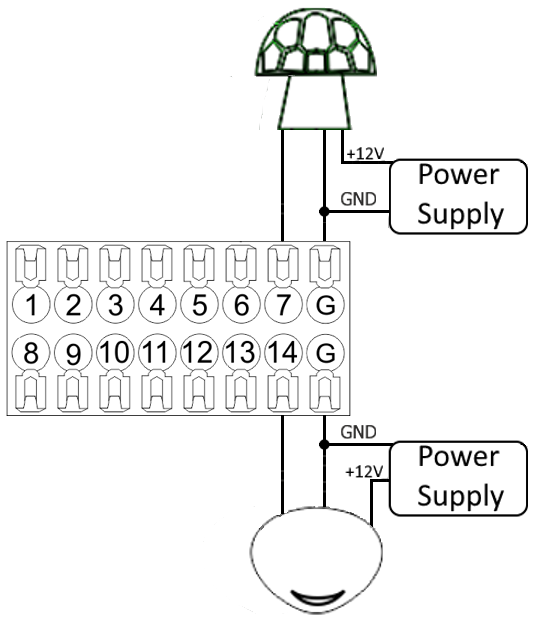
Fig. 11 connection of motion sensors/leakage sensors
Connection of buttons/switches/magnetic reed switches
Buttons and reed switches are connected to any free input in1-in28, while their second contact point is connected to GND point of the relevant METAFORSA module group. The example of connection is shown in Fig. 12-13.
 Fig. 12 connection of buttons/switching units |
 Fig. 13 connection of the magnetic reed switches (window/door position sensors) |
Connection of temperature sensors
Temperature sensors are connected to any free input in1-in28, while their second contact point is connected to GND point of the relevant METAFORSA module group. The example of connection is shown in Fig. 14.
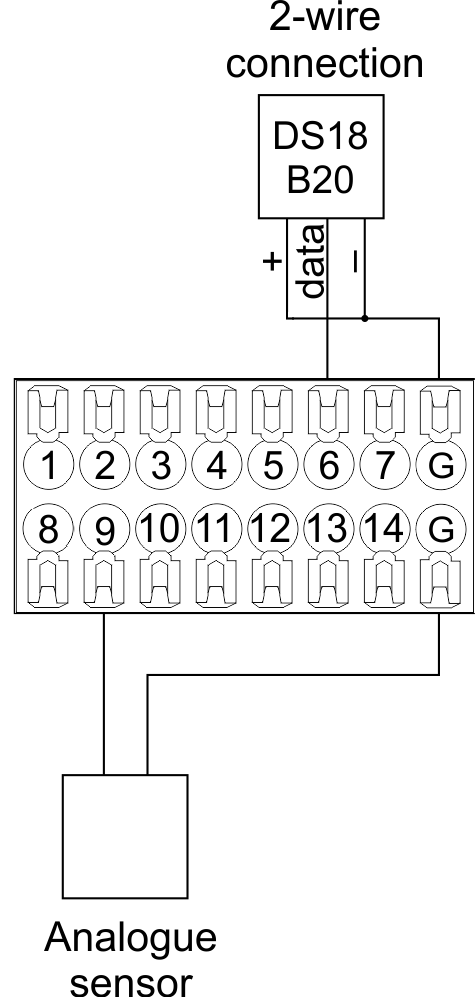
Fig. 14 connection of temperature sensors
RGB connection scheme

Fig. 15 RGB connection
WS2812B connection scheme
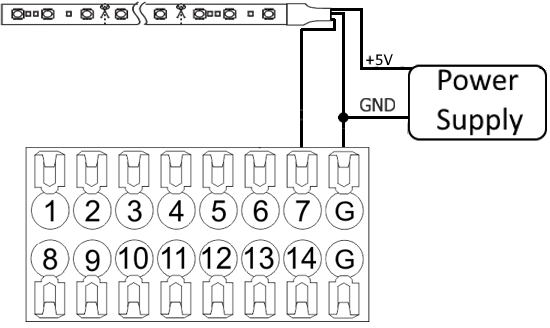
Fig. 16 WS2812B connection
RS485 connection scheme
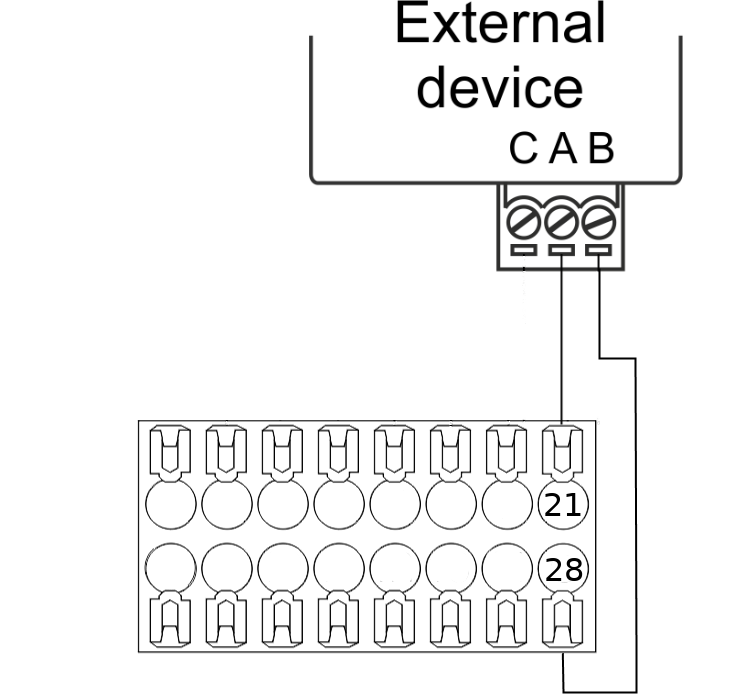
Fig. 17 RS485 connection
Connection of auxiliary equipment.
Expansion modules include Larnitech equipment connected through the CAN-bus. Such equipment includes: dimmers, RGB-backlit control modules, multimode sensors, etc. The equipment connected to the expansion port is defined automatically and does not require any preset tuning. Connector contact pin assignment is defined in Table 4. The example of connection is shown in Fig. 18.

|
| Caution! The 120 ohm terminating resistors should be installed at the end connectors between L and H contact points of CAN-bus. Ensure the connection is correct. The incorrect connection may cause sensor and/or module malfunction. |
Module installation and connection procedure
- Install the module in the switchboard on the DIN-rail and fix it with the special latch on the module base.
- Fasten the supply unit on the left side of the module.
- Connect the connector (4) having the noise filter pre-installed which is supplied complete with the module.
- Connect the connectors (5), (6).
- Connect the connectors (1), (2).
- Connect the connector (3).
- Apply power to the supply unit of METAFORSA module.
- Wait until the module is loaded, then configure it in accordance with the System Setup Instructions.
- Apply power to the connectors (1), (2).
- Check all equipment for proper operation.
METAFORSA module shut-off and deinstallation procedure
- De-energize the module by disconnecting the circuit breaker assembly of the load power supply and METAFORSA module supply unit. Verify the voltage is absent on the terminals (1), (2) of the connector wires and on the input terminals of the supply unit.
- Disconnect the load power supply connectors (1), (2).
- Disconnect the connector (3).
- Disconnect the connectors (4)-(6).
- Remove the module from the DIN-rail, releasing the latch at the bottom of the module base.
Hardware setup
To configure and control METAFORSA SMART HOUSE, you must install Larnitech software on your smartphone or tablet, which is available in App Store and Play Market. After installation, follow the System Setup Instructions.
Fault diagnostics and handling
The following are some possible faults and ways of fault handling. If you have any difficulty, or face the fault undeclared here, please contact the Technical Support: [1] or [support@larnitech.com]. There are also some tips in the FAQ section at our website [2].
The actuators do not operate:
- ensure the outputs are properly configured in the application (see System Setup Instructions);
- check the connection is correct in accordance with table 2 and paragraph 3.6;
- ensure the power is supplied to the input power contact , i.e. all circuit breaker assembly are ON.
- verify the operability of the connected equipment.
The module is off, indication absent:
- check the connection to 24V supply unit as shown in table 2 (contacts pin assignment);
- check the connection of the supply unit to 220V power mains, the indicator should be ON.
Network connection fault:
- ensure the Ethernet cable is properly wired and connected to the connector;
- ensure the LED status indicators are ON on the Ethernet connector;
- check the LAN configuration is correct, Ethernet cable loops are absent;
- METAFORSA module and the device you are connecting from are in the same network.
hold integer 0-10000 1-10 by default hold is the same as runtime hold is the bridging time in miliseconds, is used for gate and jalousie, lock; Example: hold=3500
The sensors do not operate:
- ensure the inputs are properly configured in the application (System Setup Instructions);
- check the connection is correct in accordance with table 2 and paragraph 3.7;
- ensure the METAFORSA module is ON: circuit breaker assembly is closed, indication on the supply unit is ON, the module indication corresponds to the operating status – table 3;
- check the power supply availability on the sensors;
- check the integrity of lines laid to the sensors.
The auxiliary equipment does not operate:
- check the connection is correct in accordance with table 2 and paragraph 3.8-9;
- ensure the METAFORSA module is ON: circuit breaker assembly is closed, indication on the supply unit is ON, the module indication corresponds to the operating status – table 3;
- check the integrity of the CAN lines, voltage supply on the modules.
HW Settings
| Name | Type, range | SUBID | Default | Description |
|---|---|---|---|---|
| runtime | integer 0-100 | 1-10 | 15 | runtime is the open/close time in seconds, is used for jalousie, gate, valve(2 pole);
|
| runtimeopen | integer 0-60000 | Blinds subId | Runtimeopen is the open time in milliseconds, is used for blinds; Example: runtimeopen=15000 | |
| runtimeclose | integer 0-60000 | Blinds subId | Runtimeclose is the close time in milliseconds, is used for blinds; Example: runtimeclose=15000 | |
| hold | integer 0-10000 | 1-10 | 500 | hold is the bridging time in milliseconds, is used for gate and jalousie (by default hold is the same as runtime for jalousie and gate), lock; Example: hold=3500 |
| def | string 'ON' | 1-10 | 'OFF' | def is the element status is set after restart, is used for lamp, heating, valve(1 pole); Example: def='ON' |
| stop | Char ‘R’ | 1-7 | – | (for 2-pole gate and blinds) If it is declared then by Stop command during the motion, the same impulse appears as it was at the beginning of the motion. Pole, an which the stop-impules is formed, is defined by the parameter Stop value. If it is ‘r’ or ‘R’ then stop-impulse is produced on the opposite to the start-impulse pole. If any other value is delcared (e.g., ‘d’ ) then the stop-impulse is on the same pole. If a Runtime passed after the beginning of the motion then the stop-impulse is not formed. Example: stop=’r’ |
| out | char[10] | 98 | 'LLLLHHHHP-' | Each char is responsible for the type of a particular channel
Example: out='LLB-G-V-W-' |
| dm | char[4] | 98 | ‘LLLL’ | Each char is responsible for the type of a particular channel
Example: dm=’skl-‘ |
| def | integer 0-250 | 11-14 | 100 | The default brightness level in case of a power reset (1..250). Example: def=250 |
| min | integer 0-100 | 11-14 | 0 | Minimum dimming level, example: min=10 |
| max | integer 0-100 | 11-14 | 100 | Maximum dimming level, example max=95 |
| start | integer 0-100 | 11-14 | 0 | The Start function is used for lamps that lack the minimal voltage to get turned on. If the set value is lower than the start value, the lamp is turned on at the start value and them the light is dimmed down to the set level. Example: start=60 |
| force | integer 0-100 | 11-14 | 10 | Time duration of the starting value (measured in milliseconds). Example: force=20 |
| runtime | integer 0-60000 | 11-14 | 1000 | Runtime is the speed of changing the brightness from ‘min’ to ‘max’ (measured in milliseconds). Example: runtime=1000 |
| offset | integer (+/- 0…39) | 39-46 | '0' | sensor values offset; For example, offset is -3.8 :
Example: hw="offset='-3.8'" |
| io | char[28] | 98 | io='KKKKKKKKKKKKKKKKKKKKKKKKKKKK' | Each char is responsible for the type of a particular channel
Example: io='KKKKKKKKKKKKKKKKKKKKKKKKKKKK' |
| hw | string | 98 | - | hw="...", where
Example: 1hw="io='4---zdd----t--' pwm_invert=1 lbn_bright=255 f=1000"
|
| Only for Metaforsa 3.plus | ||||
| cfg | string | 98 | 9600/8N1 | cfg='SPEED/BPS', where
Example: 1hw="cfg='9600/8N1'"
|
| [Protocol] | string | 98 | — | Protocol setting is described by protocol parameter. The following
protocols are supported:
Example: 1hw="cfg='9600/8N1' modbus"
|
| echo | on; off | 98 | 'off' | For settings check out and testing echo parameter can be used. Module
echo-reply can be turned on or off with the help of this parameter.Echo parameter value:
Example: 1hw="cfg='9600/8N1' echo='off'"
|
1 <item addr="349:1" auto-period="600" cfgid="197" name="Lamp 1" type="lamp"/>
2 <item addr="349:2" auto-period="600" cfgid="197" name="Lamp 2" type="lamp"/>
3 <item addr="349:3" auto-period="600" cfgid="197" name="Lamp 3" type="lamp"/>
4 <item addr="349:4" auto-period="600" cfgid="197" name="Lamp 4" type="lamp"/>
5 <item addr="349:5" auto-period="600" cfgid="197" name="Lamp 5" type="lamp"/>
6 <item addr="349:6" cfgid="197" name="Radiator" temperature-lag="0.2" type="valve-heating">
7 <automation name="Eco" temperature-level="16"/>
8 <automation name="Comfort" temperature-level="22"/>
9 <automation name="Hot" temperature-level="25"/>
10 </item>
11 <item addr="349:7" cfgid="197" name="Radiator" temperature-lag="0.2" type="valve-heating">
12 <automation name="Eco" temperature-level="16"/>
13 <automation name="Comfort" temperature-level="22"/>
14 <automation name="Hot" temperature-level="25"/>
15 </item>
16 <item addr="349:8" cfgid="197" name="Radiator" temperature-lag="0.2" type="valve-heating">
17 <automation name="Eco" temperature-level="16"/>
18 <automation name="Comfort" temperature-level="22"/>
19 <automation name="Hot" temperature-level="25"/>
20 </item>
21 <item addr="349:9" cfgid="197" name="Jalousie" sub-type="120" type="jalousie"/>
22 <item addr="349:11" auto-period="600" cfgid="197" name="Dimmer 1" type="dimmer-lamp"/>
23 <item addr="349:12" auto-period="600" cfgid="197" name="Dimmer 2" type="dimmer-lamp"/>
24 <item addr="349:13" auto-period="600" cfgid="197" name="Dimmer 3" type="dimmer-lamp"/>
25 <item addr="349:14" auto-period="600" cfgid="197" name="Dimmer 4" type="dimmer-lamp"/>
26 <item addr="349:16" cfgid="197" name="Door 1" type="door-sensor"/>
27 <item addr="349:17" cfgid="197" name="Door 2" type="door-sensor"/>
28 <item addr="349:18" cfgid="197" name="Door 3" type="door-sensor"/>
29 <item addr="349:19" cfgid="197" name="Door 4" type="door-sensor"/>
30 <item addr="349:20" cfgid="197" name="Door 5" type="door-sensor"/>
31 <item addr="349:21" cfgid="197" name="Door 6" type="door-sensor"/>
32 <item addr="349:22" cfgid="197" name="Door 7" type="door-sensor"/>
33 <item addr="349:23" cfgid="197" name="Door 8" type="door-sensor"/>
34 <item addr="349:24" cfgid="197" name="Door 9" type="door-sensor"/>
35 <item addr="349:25" cfgid="197" name="Door 10" type="door-sensor"/>
36 <item addr="349:26" cfgid="197" name="Door 11" type="door-sensor"/>
37 <item addr="349:27" cfgid="197" name="Door 12" type="door-sensor"/>
38 <item addr="349:28" cfgid="197" name="Door 13" type="door-sensor"/>
39 <item addr="349:29" cfgid="197" name="Door 14" type="door-sensor"/>
40 <item addr="349:30" cfgid="197" name="Door 15" type="door-sensor"/>
41 <item addr="349:31" cfgid="197" name="Door 16" type="door-sensor"/>
42 <item addr="349:32" cfgid="197" name="Door 17" type="door-sensor"/>
43 <item addr="349:33" cfgid="197" name="Door 18" type="door-sensor"/>
44 <item addr="349:34" cfgid="197" name="Door 19" type="door-sensor"/>
45 <item addr="349:35" cfgid="197" name="Door 20" type="door-sensor"/>
46 <item addr="349:36" cfgid="197" name="Door 21" type="door-sensor"/>
47 <item addr="349:37" cfgid="197" name="Door 22" type="door-sensor"/>
48 <item addr="349:38" cfgid="197" name="Door 23" type="door-sensor"/>
49 <item addr="349:39" cfgid="197" name="Door 24" type="door-sensor"/>
50 <item addr="349:40" cfgid="197" name="Door 24" type="door-sensor"/>
51 <item addr="349:41" cfgid="197" name="Door 25" type="door-sensor"/>
52 <item addr="349:43" cfgid="197" name="IR receiver" type="ir-receiver"/>
53 <item addr="349:44" cfgid="197" name="RS485" type="com-port"/>
54 <item addr="349:90" cfgid="197" name="Current" system="yes" type="current-sensor"/>
55 <item addr="349:95" cfgid="197" name="Temperature" system="yes" type="temperature-sensor"/>
56 <item addr="349:96" cfgid="197" name="Temperature" system="yes" type="temperature-sensor"/>
57 <item addr="349:97" cfgid="197" name="Temperature" system="yes" type="temperature-sensor"/>
58 <item addr="349:98" cfgid="197" hw="out='LLLLLHHHB-' dm='LLLL' io='KKKKKKKKKKKKKKKKKKKKUKKKKKK-'" logic-ver="19" name="Temperature" sn="2533726919" system="yes" type="temperature-sensor"/>
59 <item addr="349:100" cfgid="197" name="RS232" type="com-port"/>